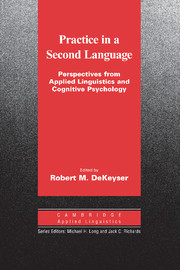Book contents
- Frontmatter
- Contents
- List of contributors
- Series editors' preface
- Introduction: Situating the concept of practice
- I: FOUNDATIONS
- Chapter 1 Input in the L2 classroom: An attentional perspective on receptive practice
- Chapter 2 Output practice in the L2 classroom
- Chapter 3 Interaction as practice
- Chapter 4 Feedback in L2 learning: Responding to errors during practice
- II: INSTITUTIONAL CONTEXTS
- III: INDIVIDUAL DIFFERENCES
- Conclusion: The future of practice
- Glossary
- Index
- References
Chapter 2 - Output practice in the L2 classroom
Published online by Cambridge University Press: 27 January 2010
- Frontmatter
- Contents
- List of contributors
- Series editors' preface
- Introduction: Situating the concept of practice
- I: FOUNDATIONS
- Chapter 1 Input in the L2 classroom: An attentional perspective on receptive practice
- Chapter 2 Output practice in the L2 classroom
- Chapter 3 Interaction as practice
- Chapter 4 Feedback in L2 learning: Responding to errors during practice
- II: INSTITUTIONAL CONTEXTS
- III: INDIVIDUAL DIFFERENCES
- Conclusion: The future of practice
- Glossary
- Index
- References
Summary
Introduction
Most second language (L2) teachers and learners likely believe that practice in production (i.e., speaking and writing), or output practice, is crucial for developing L2 proficiency. This belief in the usefulness of output practice is reflected in conventional foreign language teaching methodologies, which typically employ teaching procedures consisting of three major stages: presentation, practice, and production (i.e., the PPP model; see Byrne, 1976; Harmer, 2001). The role of output practice, however, remains a contentious issue in second language acquisition (SLA) research as characterized by a number of ongoing debates.
Advocates of the Input Hypothesis, for instance, argue that producing output serves only for generating comprehensible input from the interlocutor (Krashen, 1982, 1985, 1998). Krashen (1998) further argues that output does not make a real contribution to the development of linguistic competence because (1) output, especially comprehensible output, is too scarce, (2) it is possible to attain high levels of linguistic competence without output, and (3) there is no direct evidence that output leads to language acquisition. In the Natural Approach, which is based upon Krashen's Input Hypothesis, teachers are guided not to force their students to produce the target language but rather to expect that “speech (and writing) production emerges as the acquisition process progresses” (Krashen & Terrell, 1983, p. 58). VanPatten (1996) also advocates abandoning mechanical output practice.
- Type
- Chapter
- Information
- Practice in a Second LanguagePerspectives from Applied Linguistics and Cognitive Psychology, pp. 51 - 84Publisher: Cambridge University PressPrint publication year: 2007
References
- 26
- Cited by



